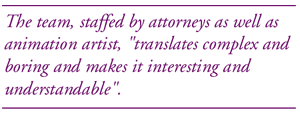Wired Covers Our Courtroom Animation Services

Law and Order (and Animation)
March 22, 2001
2:00 a.m. PST
by Robin Clewley
For two hours, Flight 58 cruises steadily with the Gulf Stream. Suddenly the plane shoots skyward, and two seconds later plummets hundreds of feet.
Passengers scream in terror, luggage flies through the air, hot coffee scalds flight attendants, and pilots' knuckles whiten, gripped around their controls.
The plane doesn't crash. Severe turbulence, not mechanical failure, caused the plane to dive.
There are no serious injuries.
But American Airlines still will surrender $2.2 million in what remains the largest pay out in history for an air-turbulence case. Credit a compelling clip of computer animation. "The emotion that we were  getting with that animation, it was like a bomb went off in the plane," said Ken Lopez, whose company developed the animation for the trial, which involved a McDonnell Douglas DC-10-10, regarding a 1995 flight from Los Angeles to New York.
getting with that animation, it was like a bomb went off in the plane," said Ken Lopez, whose company developed the animation for the trial, which involved a McDonnell Douglas DC-10-10, regarding a 1995 flight from Los Angeles to New York.
To demonstrate their case, attorneys representing 13 passengers from American Airlines Flight 58 showed a two-dimensional animation of the incident to a Manhattan jury. With a picture of the Statue of Liberty on the screen to lend scale, the plane's rise and fall matched the height of the statue.
"It was much more powerful than having an expert explain, 'OK, five seconds into this encounter the plane was at 35,000, then it dropped 200 feet, then it climbed 300 feet,'" said Daniel Rose, one of the attorneys.
But the plaintiffs' success in the case does not exactly portend a future where courtrooms are saturated with cartoons. Computer-generated animation is not only expensive but it is not always effective.
For reality-based computer animation to be admissible in court, it must correspond directly to the evidence before the jury can see it. The judge sees it first during the presentation of evidence. If it does not correspond directly, the judge can throw it out, said trial attorney Jack King.
But the animation, created by Animators at Law, worked perfectly in the American Airlines case. The team, staffed by attorneys as well as animation artists, "translates the complex and boring and makes it interesting and understandable," Lopez said.
"The ultimate (award) was 10 times the amount American Airlines expected to hand out," Rose said.
The risk doesn't always outweigh the gain.
"If you turn (the animation) into a video game or some sort of carnival ride, you're taking away the effects of a tragic event," Rose said. "You could minimize or diminish the actual incident."
The expense of computer animation has dropped dramatically since the mid-1980s, when costs were measured in thousands of dollars per second, King said. However, expert fees have gone up. If the client isn't wealthy, the last thing they will spend money on is computer animation.
Animators at Law charges between $50,000 to $200,000 per case.
"It's not cheap," said attorney Robert Clifford, who is representing the families of the victims in last year's crash of Alaska Airlines 261. "Bring your checkbook."
Clifford said he plans to use computer animation for the case, tentatively scheduled to go to trial in April 2002.
Roger L. McCarthy, chairman of Exponent, an engineering firm that provides technical experts for trials and develops animation for the courtroom, believes computer animation and video can hurt a case. If it's technically inaccurate or tugs too much at the juror's heartstrings, the strategy can backfire, he said.
"There is great possibility of error," he said.
McCarthy once saw a courtroom animation depicting a mechanical device working with reverse gravity.
The discrepancy between animations that are scientifically accurate and those that are created to "win," is vast, McCarthy said.
"The thing that sets us apart from (engineering animation companies) is that our mission is to persuade and to win," Lopez said. "Engineers are not taught that mindset."
McCarthy said it's the judge's job to throw out evidence when the emotion evoked by an animated film outweighs the evidence. But many judges will leave it to be cross-examined by the opposing attorney in court, he said.
And regardless of the accuracy of the animation, it can have devastating effects on a jury because of the amount of information to be absorbed visually. Nevertheless, Rose said computer animation makes the story easier to tell, even though it doesn't necessarily increase the odds of winning a case.
Lopez said the beauty of computer animation is that it can captivate a jury.
"Juries will think, 'They created a little PBS show for me. I'm going to remember everything now.'"


